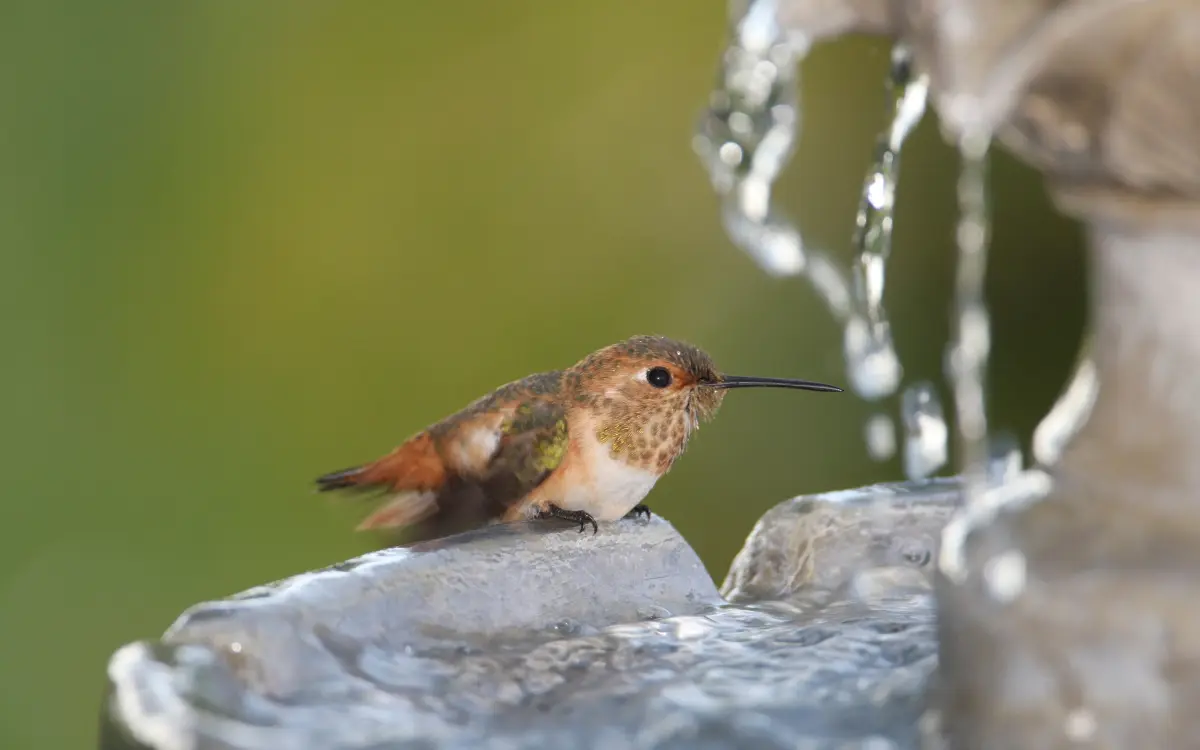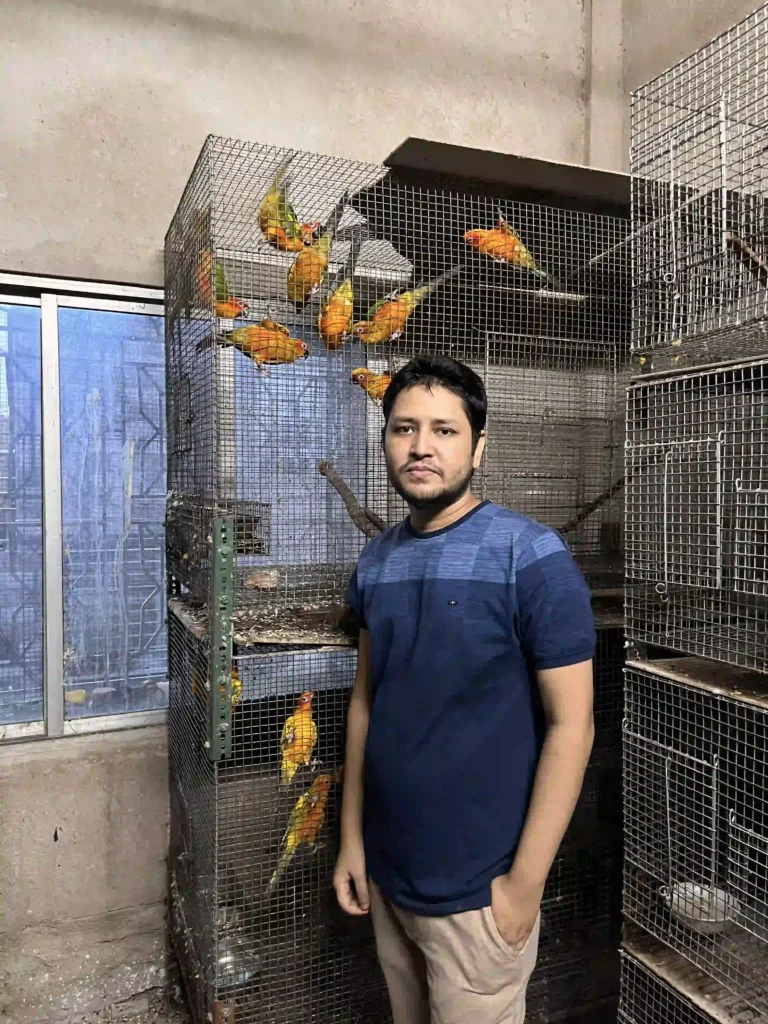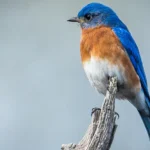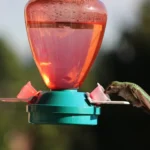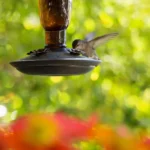Yes, hummingbirds do use bird baths, but they have specific preferences compared to larger birds. While they need water for drinking and bathing, they are more attracted to shallow baths or those with moving water, like misters or fountains.
Traditional deep bird baths aren’t ideal for their small size and delicate behavior, so creating a hummingbird-friendly water source is key to attracting them.
Hummingbird Water Needs
Hummingbirds need water not only for drinking but also for bathing to keep their feathers clean and healthy. However, unlike larger birds, they prefer shallow water sources or fine misting, which better suits their small size and delicate nature.
Hummingbirds are particularly drawn to moving water, such as misting systems or fountains, rather than deep bird baths.
The gentle flow or spray mimics natural rain or dew, allowing them to hover and bathe in mid-air.
Traditional bird baths, with deep, still water, are less appealing to hummingbirds. Providing the right water source is essential to meet their unique needs.
What Type of Bird Baths Do Hummingbirds Prefer?

Hummingbirds prefer bird baths that offer shallow water with gently moving features, making them ideal for the birds’ small size and unique bathing habits.
Unlike larger birds, hummingbirds avoid deep baths and instead gravitate toward sources that mimic natural conditions, such as misters, drippers, and fountains.
These features create a fine spray or gentle movement in the water, which hummingbirds love to hover around, bathing in the mist or shallow ripples.
Misters, in particular, are very attractive to hummingbirds, as the fine droplets provide the perfect environment for them to cool off and clean their feathers without submerging.
Drippers and fountains with slow, bubbling water also appeal to them, as the subtle movement entices the birds to bathe.
In contrast, traditional deep bird baths are often too large or too deep for hummingbirds, making it harder for them to access the water comfortably.
For a hummingbird-friendly setup, it’s best to provide shallow trays or basins no deeper than half an inch, combined with features like misters or gently bubbling fountains, to create the perfect bathing environment.
What Type of Bird Baths Do Hummingbirds Prefer?
Hummingbirds prefer bird baths that offer shallow water with gently moving features, making them ideal for the birds’ small size and unique bathing habits.
Unlike larger birds, hummingbirds avoid deep baths and instead gravitate toward sources that mimic natural conditions, such as misters, drippers, and fountains.
These features create a fine spray or gentle movement in the water, which hummingbirds love to hover around, bathing in the mist or shallow ripples.
Misters, in particular, are very attractive to hummingbirds, as the fine droplets provide the perfect environment for them to cool off and clean their feathers without submerging.
Drippers and fountains with slow, bubbling water also appeal to them, as the subtle movement entices the birds to bathe.
In contrast, traditional deep bird baths are often too large or too deep for hummingbirds, making it harder for them to access the water comfortably.
For a hummingbird-friendly setup, it’s best to provide shallow trays or basins no deeper than half an inch, combined with features like misters or gently bubbling fountains, to create the perfect bathing environment.
Using Misters and Fountains to Attract Hummingbirds
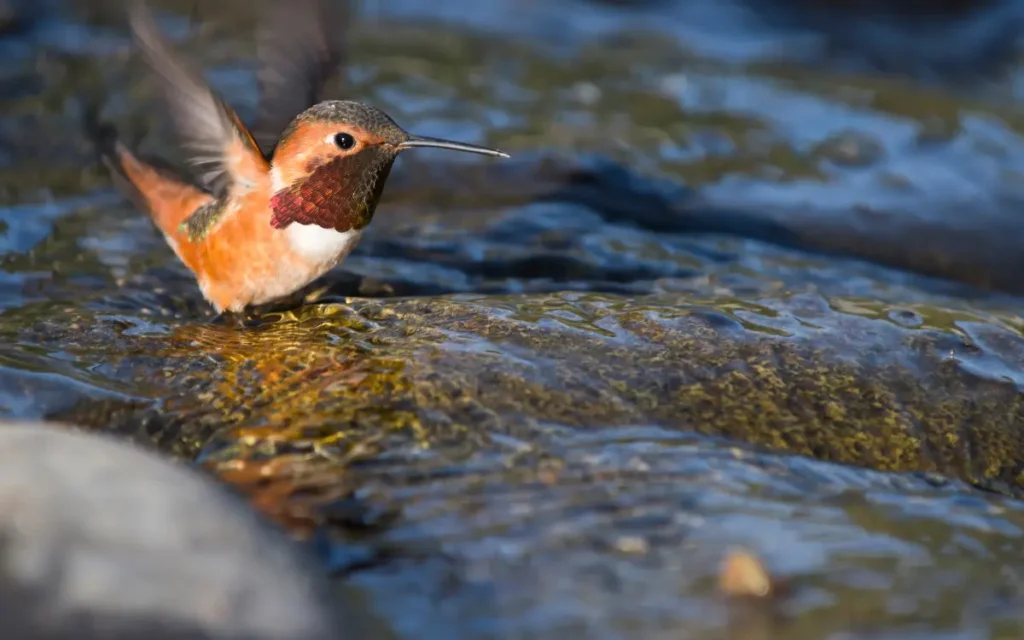
Misters are highly effective at attracting hummingbirds because they create a fine, gentle spray that hummingbirds love to hover in.
The mist mimics natural rainfall or dew, allowing hummingbirds to bathe and cool off without having to land or submerge themselves in water.
Hummingbirds often enjoy darting in and out of the mist, which not only helps them stay clean but also refreshes them on hot days.
Fountains with bubbling or gently flowing water are another great way to draw hummingbirds. Unlike deep, still bird baths, the gentle movement of water in fountains appeals to them.
Bubbling fountains create a light, soothing sound, and the rippling water provides the perfect environment for hummingbirds to sip and bathe without the risk of drowning.
To install these features, place misters or fountains in a shaded spot near plants or flowers that already attract hummingbirds.
Ensure the water source is shallow or flowing lightly, and position it where hummingbirds can easily see it from their usual feeding spots.
By combining misters or fountains with a hummingbird feeder, you create an inviting, multi-purpose space that hummingbirds will frequent.
Shallow and Safe Bathing Options
Hummingbirds prefer shallow bird baths or trays with water no deeper than half an inch. Shallow water allows them to safely drink and bathe without the risk of drowning, making it essential to choose a bath designed for their small size.
Regularly refreshing and cleaning the water is crucial to prevent contamination from debris, algae, or bacteria, ensuring the health and safety of the birds.
Placing the bird bath in a shaded area helps keep the water cool, preventing it from heating up or evaporating too quickly in direct sunlight.
Shaded spots also provide a more secure environment, reducing the risk of overheating and making the area more comfortable for hummingbirds to visit.
These simple steps will create a safe and inviting space for hummingbirds to bathe.
How to Create a Hummingbird-Friendly Water Source
Creating a hummingbird-friendly water source in your yard is simple and rewarding. Start by combining shallow bird baths with misters or drippers.
Hummingbirds prefer shallow water no deeper than half an inch, and adding a mister or dripper can create the gentle movement of water that attracts them. Misters produce a fine spray that hummingbirds love to hover in, while drippers provide a steady flow that mimics natural water sources, making the area more inviting.
To enhance the environment, surround the water source with nectar-rich plants or flowers that hummingbirds are naturally drawn to, such as trumpet vine, bee balm, or fuchsia. This not only provides a natural setting but also gives hummingbirds a place to rest and forage between visits to the water source.
Position the water feature in a shaded area to keep the water cool and fresh, and to protect the birds from overheating. Regularly clean and refill the water to maintain a healthy, safe space for hummingbirds.
By combining these elements, you’ll create an ideal environment for hummingbirds to drink, bathe, and enjoy your yard.

